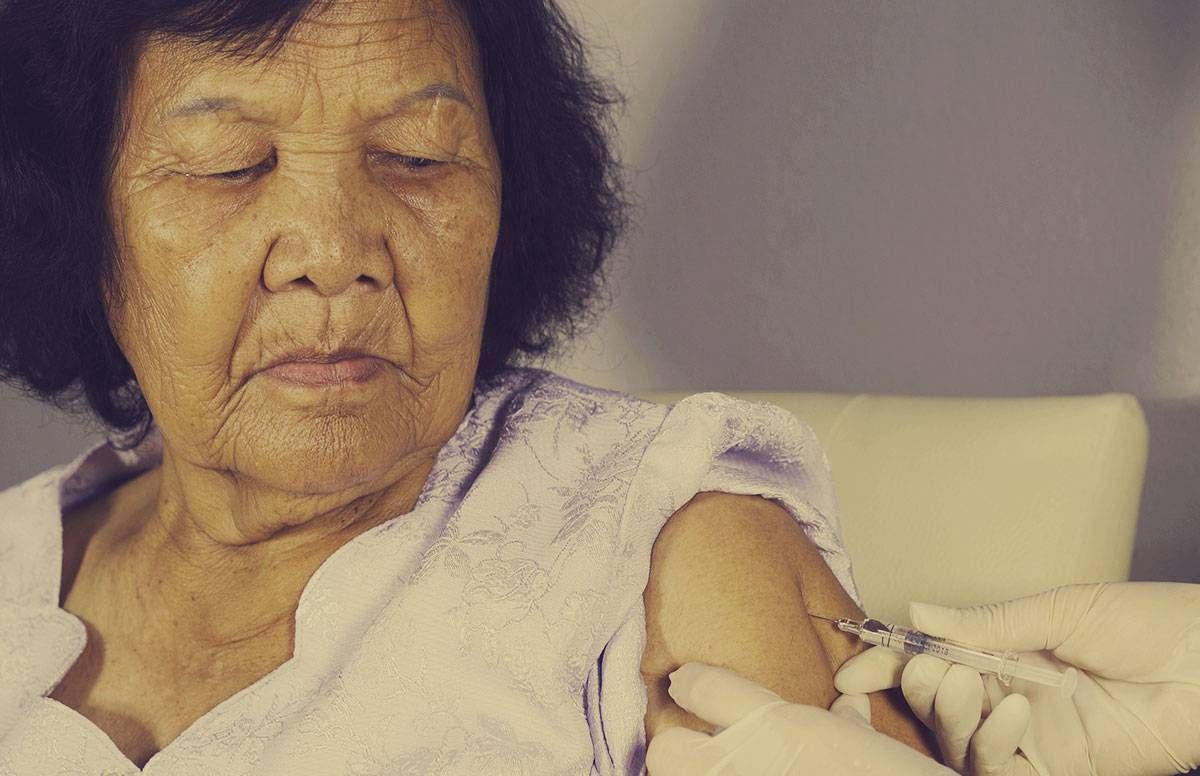How Important Is That High-Dose Flu Shot?
Here's what makes it different from regular influenza vaccines
In case you missed it, the beginning of this winter’s flu season was heralded by a new TV commercial about a specific type of flu vaccine called Fluzone High-Dose.

In the ad, an older woman runs into a number of contagious “Typhoid Marys” — a man coughing in a crowded elevator, a snotty-nosed schoolgirl on a bus — people who somehow misread the work email about staying home when they’re sick and those with self-awareness issues that preclude them from covering their cough. We’ve all met them.
As drug ads go, the Fluzone commercial has a light, even humorous touch. It’s accurate, non-threatening (rather than, “Talk to your doctor soon about Nasdaquiri ™ before you die a sad and entirely preventable death”) and it’s refreshing in that it’s the first drug ad you’ve seen in months that wasn’t talking about moderate-to-severe plaque psoriasis.
A Special Vaccine for Older Adults
So, what is Fluzone High-Dose? It’s an injectable flu vaccine approved by the Food and Drug Administration (FDA) for people age 65 and older. Why do older adults need a specially formulated vaccine? Because influenza hits people over 65 the hardest.
Although influenza also strikes the very young and those with complicated medical conditions hard, up to 85% of flu deaths and 70% of flu-related hospitalizations occur in the over-65 age group, according to the Centers for Disease Control and Prevention (CDC).
For each of those three groups, this increased vulnerability to influenza is driven by a sub-optimal immune system — one that is underdeveloped in infants or that is hobbled by poor health or the aging process.
Why do older adults need a specially formulated vaccine? Because influenza hits people over 65 the hardest.
Although health officials stress the importance of getting vaccinated for these three groups, older adults don’t benefit as well from regular flu vaccinations as younger people do.
Fluzone High-Dose hit the market in 2010 and was designed with that problem in mind. It includes four times more antigen (the flu proteins that our immune system learns to recognize and attack) than the typical flu vaccine.
'Yelling' Louder at the Immune System
Vaccine immunology is complicated. It’s still unclear why, for instance, some vaccines offer nearly complete protection, and some — like influenza — offer about 60% protection in the best of years.
The concept behind Fluzone High-Dose is that “yelling” at the immune system four times louder will make it get the message. But other than the requisite safety and effectiveness research needed to receive FDA approval, there has not been a flurry of clinical research on Fluzone High-Dose since it was released.
The evidence we do have is encouraging: One trial showed that it was 24% more effective in preventing flu in older adults and another showed that it led to decreased flu-related hospitalizations.
This Season's Flu Vaccines
This year, 81% of the flu vaccine supply will be “quadrivalent” — meaning it will include the four influenza strains that are anticipated to be the major pathogens in this winter’s flu season.
Typically, that’s determined by noting the most active strains from last year’s flu season, and the top strains in the southern hemisphere’s flu season. Flu viruses go there while we enjoy summer here in the northern hemisphere.
If you play Scrabble, it might interest you to know that this year’s vaccine contains an A/Brisbane/02/2018 A(H1N1)pdm09-like virus, an A/Kansas/14/2017 A(H3N2)-like virus, a B/Colorado/06/2017-like (B/Victoria lineage) virus and a B/Phuket/3073/2013-like (B/Yamagata lineage) virus.
According to the CDC, those are the strains currently making the early rounds of influenza across the U.S., so that correlation with the vaccine is good news.
This year’s Fluzone High-Dose contains just three flu strains (a “trivalent” vaccine), and does not contain the B/Phuket strain, which makes up just 1.6% of flu cases so far this year. But earlier this month, Sanofi Pasteur — the French pharmaceutical company that produces Fluzone High-Dose — received FDA approval to market a quadrivalent version for the 2020-21 flu season.
Cost and Availability
As the Fluzone High-Dose ad notes, the vaccine is free with Medicare Part B, the section of Medicare that covers things like doctor visits, outpatient services and diagnostic screenings. According to the manufacturer, if you are paying out-of-pocket for Fluzone High-Dose, the list price is $48.50.
Price is one thing; availability is another. In some years, vaccine production problems have led to vaccine shortages. Late last month, pharmacies reported spotty outages of Fluzone High-Dose. Both the manufacturer and the CDC described it as a distribution problem rather than an overall shortage.
The CDC has projected that vaccine manufacturers will produce 162 million to 169 million doses this year, and they’ve already delivered 162 million.
There's Also Fluad
Is there an alternative to Fluzone High-Dose for older adults? Yes. It’s called “Fluad,” with the “ad” standing for “adjuvant”— an added ingredient that is thought to help the immune system better recognize and respond to the viral proteins in the vaccine.
In Fluad’s case, the adjuvant is called “MF59,” which sounds like something out of a James Bond movie and should, therefore, boost ANYONE’S immune system.
As with Fluzone High-Dose, there’s only limited evidence that Fluad is significantly more effective than the regular vaccine, and there are no randomized studies that compare the two head to head. Loser buys the Kleenex.
The CDC is picking no favorites in its recommendation that older adults get vaccinated. Fluzone High-Dose and Fluad might offer some additional benefit, but the overall message seems to be “Get some form of vaccination, and get it soon.”
And for heaven’s sake, cover your cough.

